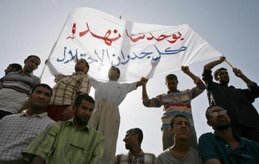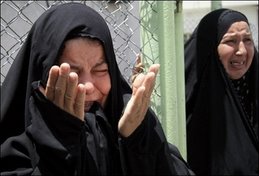The view from Baghdad: Mounting death toll which makes a mockery of US optimism
By Kim Sengupta
Published: 11 September 2007
By the time General Petraeus had finished speaking yesterday the slaughter in Iraq for the previous 24 hours could be tallied. It was not an exceptionally violent day by the standards of Iraq: seven US soldiers lay dead and 11 injured in the capital; other instances of sectarian violence included a suicide bomb which had killed 10 and wounded scores near Mosul while 10 bodies were found in Baghdad. Three policemen were killed in clashes in Mosul, and a car bomb outside a hospital in the capital had exploded, killing two and wounding six.
In Baghdad, on the surface the overt violence appears to have diminished. There are fewer loud explosions. But, the city is now being partitioned by sectarian hatred and fear; by concrete walls and barbed wire. Claims that the US military strategy is paving the way for a stable society bear little resemblance to the reality on the ground.
The US is accused of manipulating figures relating to violence to fit their case, ignoring evidence which shows that the influx of 30,000 troops has done little to end the continuing bloodshed.
The death of Omar al-Husseini in the Huriya district of Baghdad is one of many which does not even figure in the American reckoning. His killers, masked and carrying guns, dragged him away as his mother wept and his father pleaded for mercy. That was the last time they saw their son alive. Three weeks later they heard that he had been killed.
Omar was 20. His killers were Shia, he was a Sunni, the victim of a spree of murders which has ethnically cleansed neighbourhoods through the city. But both the US military and the Iraqi police have told his parents that as far as they are concerned the abduction and killings were purely criminal acts. This means, statistically, that his death is not included by the US in the calculations for sectarian killings produced yesterday.
The causes behind the daily death toll, if addressed at all, draw conflicting accounts. Mourners carried the coffin of a young mother along the streets of Sadr City yesterday. She had been killed, said the locals, along with her two daughters when US and Iraqi government forces had stormed four homes. The US military confirmed they had exchanged small-arms fire during the operation, but insisted they had no reports of civilian casualties. Also yesterday, attendants at the Baghdad morgue did their round of collecting bodies, nameless victims of faceless killers.
Omar's father, 48-year-old Barzan, said the attack on his son came after the Mehdi Army, a Shia militia, declared that they must leave their home. " We were going to leave, we did not want any trouble. We had very excellent relations with our Shia neighbours, but they could not do anything to help us ", he said. "They [the Mehdi Army] were also saying that my two sons were involved with the insurgents. That was not true, they had nothing to do with politics. Mohammed was away when they came, but Omar was there and they took him away and shot him. The police and the Americans say he was an Ali Baba [thief] and this killing was something to do with that. But everyone knows why he died, it is because we are Sunnis."
Barzan had fled with his family to the Khadrah district where he found refuge with his cousin. They could not watch much of General Pertraeus's address on satellite TV because of a power cut. Four years after the war, electricity supply in the city has dwindled to one hour a day.
Not far away from Barzan's new home are other houses, some with singe marks on doors and windows, properties of Shia who had been terrorised and driven out the other way. The walls being put up by US contractors at a record speed are formalising this break-up of Baghdad along sectarian lines. Militias rule the roost in the newly created ghettos; armed young men with sunglasses manning checkpoints, collecting levies from passing traffic, and meting out their own justice to victims who would never make the calculations on the effects of the surge.
The Americans at first welcomed the forming of the vigilante groups, calling them "guardians"; in some areas this was described as part of the " Sunni awakening", away from the insurgency. But this began to be tempered after tales of extortion began to surface, and now some have been arrested for "suspected al-Qa'ida ties".
The purge of the neighbourhoods, however, has helped to bring down the number of violent deaths, providing fewer sectarian targets. Residents seeing their neighbours being driven out are too afraid to do anything. Ali Mohammed, a Shia in Huriya, spread his hands in a gesture of hopelessness. " If we say anything we will be attacked," he said. "So what can we say? We know of people being driven out, being killed, but there is no one we can go to."
Others say the surge itself had led to the rise in intimidation by the militias. Rashid Kamal, in Amariya, said: "The Americans drove out the militias, but they only went into other areas. It is this which led to the places where Sunnis and Shia were living together being split up. People who have been neighbours for generations were forced to leave in a few hours."
Since the start of the surge, the deaths of US soldiers have fallen from a peak of 120 in May to 56 in August. But there are significant discrepancies between the figures for civilian deaths presented by the US military and independent estimates. According to American authorities, 165 civilians were murdered in Baghdad in August, a slight increase on the previous two months, but a sizeable decrease since the beginning of the surge. However, figures released by Iraq's Interior Ministry suggest that at least 428 people were murdered in Baghdad last month, and 612 in July. The Associated Press's tally of civilian deaths throughout Iraq in August was 1,809, the highest this year.
Under the US military's rules, a corpse shot in the back of the head is a " sectarian" killing, while one shot through the front is deemed to be a criminal one. Even under this arbitrary criterion it would be difficult on many occasions to distinguish which particular group a death may fall under. Attendants at the Baghdad morgue point out that victims often bear multiple gunshot wounds.
Hours before General Petraeus appeared in Washington, the Iraqi Prime Minister, Nouri al-Maliki, gave his own assessment of the surge. "The key to reconstruction, economic development and improving peoples' standards of living is security," he said. Violence in Baghdad, he declared, had " dropped by 75 per cent". He failed, however, to provide any figures.
تقرير من جريدة الأندبندت البريطانية تثبت عدم مصداقية عدد ضحايا الفتنة الطائفية التي أستخدمها الجنرال بتريوس في شهادته أمام الكونجرس أمس. يقول الصحفي كيم سنكوبتا بناءاً على تعليمات أمريكية يتم تصنيف ضحايا الجرائم الطائفية على أنهم ضحايا جرائم عادية كي يدعي المحتلون تحقيق نجاحات من جراء ‘زيادة‘ عدد الجنود الأمريكان في بغداد









